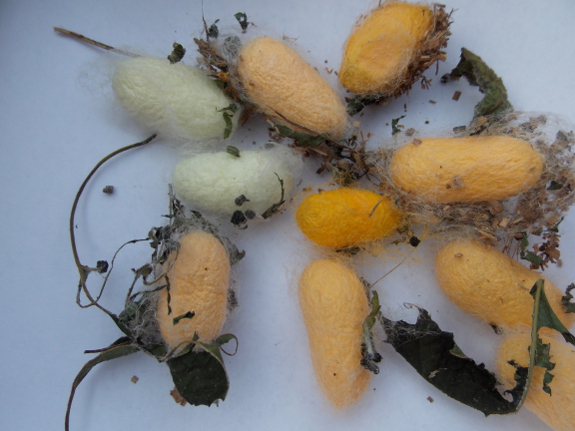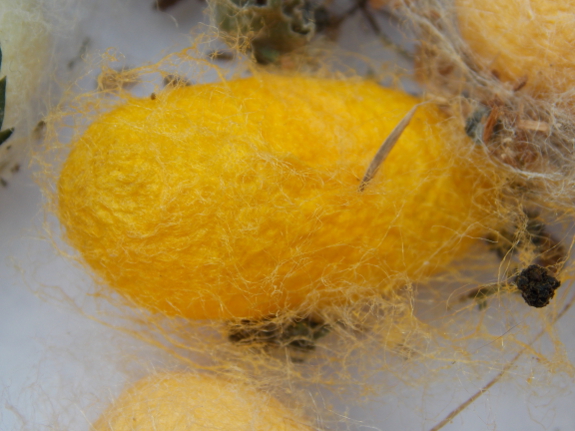
Making silk out of silkworm cocoons

Due to some dieoff
during our final
silkworm week,
we ended up with only ten silkworm cocoons, but that should be
enough to carry our livestock on to the next generation. I
was amazed by the colors of the cocoons, especially the brilliant
orange one that almost looks fake. My understanding is that
commercial silkworm producers select for white cocoons so that
they don't have to bleach the silk before dying it.
One of our chicken blog readers wrote in to ask
if she could have our cocoons after we're done with them, which
made me realize it's far from common knowledge how silk is
produced. Unfortunately, you have to decide whether to use
your cocoons to make silk or whether to let the moths escape and
breed, so our cocoons will end up being useless from a fiber
perspective.

If you're not trying to
breed the moths, though, it is quite feasible to make silk on the
backyard scale if you're up for some tedious labor. Just
boil the cocoons once they're fully formed, which kills the pupae
inside and dissolves the glues binding the silk together.
Each cocoon is made up of one extremely long strand, which you can
tease apart and wind up, then weave like any other thread.
The reason you can't raise the moths and still use the thread is
that the mature insect gnaws its way to freedom, breaking that
long thread into many smaller pieces that are much less useful.
Mark and I are still
on the fence about whether silkworm culture is an efficient use of
time, but we're definitely going to breed our moths and start
tweaking the procedure so it works better. Stay tuned for
round two, coming up next month.
Want more in-depth information? Browse through our books.
Or explore more posts by date or by subject.
About us: Anna Hess and Mark Hamilton spent over a decade living self-sufficiently in the mountains of Virginia before moving north to start over from scratch in the foothills of Ohio. They've experimented with permaculture, no-till gardening, trailersteading, home-based microbusinesses and much more, writing about their adventures in both blogs and books.
Want to be notified when new comments are posted on this page? Click on the RSS button after you add a comment to subscribe to the comment feed, or simply check the box beside "email replies to me" while writing your comment.

This was an interesting post that I should pass on to my fiber artist friend, even though she prefers indigo. She has had chickens and seems on the same wavelength.
You think I could market any of the mulberry seedlings in our backyard urban homestead nursery? I am kind of kidding since I think they are being sold in bulk online for like 2.50 for 100...
I think it is an interesting idea and harkens back to the Sow's Ear purse analogy.
I just watched a video yesterday that showed yellow/orange cocoons, and I was surprised as well. http://www.youtube.com/watch?v=Bd4K1AYEvTc I also found it interesting at how finely they minced the mulberry leaves for the emerging silkworms. I have really enjoyed your silkworm project, thanks for the updates!